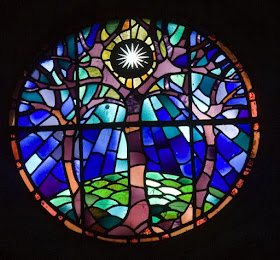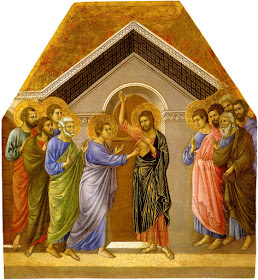The window by Dom Theodore has continued to provided much food for thought and prayer. It was the feast day of the great Carmelite saint, St Teresa Benedicta of the Cross - Edith Stein - on the 9th August which brought me right back to Dom Theodore's window and to our icon. I came across a passage in her book
The Hidden Life which seemed to echo what the window is saying.
'The work of salvation takes place in obscurity and stillness. In the heart’s quiet dialogue with God the living building blocks out of which the kingdom of God grows are prepared, the chosen instruments for the construction forged. The mystical stream that flows through all centuries is no spurious tributary that has strayed from the prayer life of the church it is its deepest life. ' ( See
here )
Reading her work is is apparent how she draws deeply upon the Carmelite tradition of the heart, and how central the Sacred Heart was to her spiritual life. The evidence of her 'heart spirituality' is much in evidence in her writings. In 1940, for example, she writes of the 'Hidden life and Epiphany':
'When the gentle light of the advent candles begins to shine in the dark days of December a mysterious light in a mysterious darkness it awakens in us the consoling thought that the divine light, the Holy Spirit, has never ceased to illumine the darkness of the fallen world. He has remained faithful to his creation, regardless of all the infidelity of creatures. And if the darkness would not allow itself to be penetrated by the heavenly light, there were nevertheless some places always predisposed for it to blaze. A ray from this light fell into the hearts of our original parents even during the judgment to which they were subjected. This was an illuminating ray that awakened in them the knowledge of their guilt, an enkindling ray that made them burn with fiery remorse, purifying and cleansing, and made them sensitive to the gentle light of the star of hope, which shone for them in the words of promise of the "protoevangelium," the original gospel. As were the hearts of the first human beings, so down through the ages again and again human hearts have been struck by the divine ray. Hidden from the whole world, it illuminated and irradiated them, let the hard, encrusted, misshapen matter of these hearts soften, and then with the tender hand of an artist formed them anew into the image of God. Seen by no human eye, this is how living building blocks were and are formed and brought together into a Church first of all invisible. However, the visible Church grows out of this invisible one in ever new, divine deeds and revelations which shed their light ever new epiphanies. The silent working of the Holy Spirit in the depths of the soul made the patriarchs into friends of God. However, when they came to the point of allowing themselves to be used as his pliant instruments, he established them in an external visible efficacy as bearers of historical development, and awakened from among them his chosen people. Therefore, Moses, too, was educated quietly and then sent as the leader and lawgiver.' (
Read here.)
This passage to me helps me to read Dom Theodore's window, but also to read the icon in a new way. A relationship to Christ in the heart of of creation is one in which the light penetrates the human heart and illuminates it from within: it is an invisible process by which God's presence is experienced in the world. This sense of humanity being open to the penetration of divine light is very much a theme in Teilhard. And wherever we look in Saint Edith's work we find the heart as that point in the universe in which God's light seeks to make a home. A beautiful example is her poem: I Will Remain With You.
You reign at the Father's right hand
In the kingdom of his eternal glory
As God's Word from the beginning.
You reign on the Almighty's throne
Also in transfigured human form,
Ever since the completion of your work on earth.
I believe this because your word teaches me so,
And because I believe, I know it gives me joy,
And blessed hope blooms forth from it.
For where you are, there also are your own,
Heaven is my glorious homeland,
I share with you the Father's throne.
The Eternal who made all creatures,
Who, thrice holy, encompasses all being,
In addition has a silent, special kingdom of his own.
The innermost chamber of the human soul
Is the Trinity's favorite place to be,
His heavenly throne on earth.
To deliver this heavenly kingdom from the hand of the enemy,
The Son of God has come as Son of Man,
He gave his blood as the price of deliverance.
In the heart of Jesus, which was pierced,
The kingdom of heaven and the land of earth are bound together.
Here is for us the source of life.
This heart is the heart of the triune Divinity,
And the center of all human hearts
That bestows on us the life of God.
It draws us to itself with secret power,
It conceals us in itself in the Father's bosom
And floods us with the Holy Spirit.
This Heart, it beats for us in a small tabernacle
Where it remains mysteriously hidden
In that still, white host.
That is your royal throne on earth, O Lord,
Which visibly you have erected for us,
And you are pleased when I approach it.
Full of love, you sink your gaze into mine
And bend your ear to my quiet words
And deeply fill my heart with peace.
Yet your love is not satisfied
With this exchange that could still lead to separation:
Your heart requires more.
You come to me as early morning's meal each daybreak.
Your flesh and blood become food and drink for me
And something wonderful happens.
Your body mysteriously permeates mine
And your soul unites with mine:
I am no longer what once I was.
You come and go, but the seed
That you sowed for future glory, remains behind
Buried in this body of dust.
A luster of heaven remains in the soul,
A deep glow remains in the eyes,
A soaring in the tone of voice.
There remains the bond that binds heart to heart,
The stream of life that springs from yours
And animates each limb.
How wonderful are your gracious wonders!
All we can do is be amazed and stammer and fall silent
Because intellect and words fail.
And I Remain With You
( See
Here. )
I think Teilhard would have loved this poem - as now I do! Saint St Teresa Benedicta of the Cross, pray for all those who seek the Sacred Heart.
 Despite the rather long gap between this blog and the last, the icon has still been working! Perhaps it has been working on a much deeper level. Right through advent and Christmas the icon served to focus my mind on the meaning of the incarnation and the nativity of Jesus. Above all it has, I believe, drawn me to reflect on the essential message of the Heart of the Saviour: the mystery of God’s Love and mercy. By focusing on this at the very centre of the icon, the mind naturally turns to the great models of humility – the Virgin and St. John the Baptist. In doing so, it brings us time and time again to Mathew 11.29-30 in which Christ tells us precisely what we must learn from him: we have to cultivate the growth of a gentle and humble heart. In this one instruction is revealed the doorway through which we must pass. In this brief statement we find the direction we must take in order to become united with Christ Omega. By taking this path we find that all other roads converge: humility is the way. With this in mind I paid a visit to Westminster Cathedral on the feast of St Thomas Becket. And, whilst looking for something else encountered the chapel which contains the remains of Cardinal Herbert Vaughan (1832–1903). (Read here. )
Despite the rather long gap between this blog and the last, the icon has still been working! Perhaps it has been working on a much deeper level. Right through advent and Christmas the icon served to focus my mind on the meaning of the incarnation and the nativity of Jesus. Above all it has, I believe, drawn me to reflect on the essential message of the Heart of the Saviour: the mystery of God’s Love and mercy. By focusing on this at the very centre of the icon, the mind naturally turns to the great models of humility – the Virgin and St. John the Baptist. In doing so, it brings us time and time again to Mathew 11.29-30 in which Christ tells us precisely what we must learn from him: we have to cultivate the growth of a gentle and humble heart. In this one instruction is revealed the doorway through which we must pass. In this brief statement we find the direction we must take in order to become united with Christ Omega. By taking this path we find that all other roads converge: humility is the way. With this in mind I paid a visit to Westminster Cathedral on the feast of St Thomas Becket. And, whilst looking for something else encountered the chapel which contains the remains of Cardinal Herbert Vaughan (1832–1903). (Read here. ) This got me thinking about Vaughan and humility which resulted in the rediscovery of his translation of Fr. Cajetan Mary da Bergamo’s great book on humility, Humility of Heart. The Cardinal worked on this translation in his dying days and was his way of stating what, ultimately, he had learnt in his life. It is an inspiring book which is still in print, and well worth reading. (You can also read it on line, HERE. ) I was looking for his predecessor, Cardinal Manning (1808-1892) whose book on the Glories of the Sacred Heart I have been reading. ( Read Here. ) So, the discovery of Vaughan's translation is a wonderful way to end the year and begin a new one.
This got me thinking about Vaughan and humility which resulted in the rediscovery of his translation of Fr. Cajetan Mary da Bergamo’s great book on humility, Humility of Heart. The Cardinal worked on this translation in his dying days and was his way of stating what, ultimately, he had learnt in his life. It is an inspiring book which is still in print, and well worth reading. (You can also read it on line, HERE. ) I was looking for his predecessor, Cardinal Manning (1808-1892) whose book on the Glories of the Sacred Heart I have been reading. ( Read Here. ) So, the discovery of Vaughan's translation is a wonderful way to end the year and begin a new one. 




























